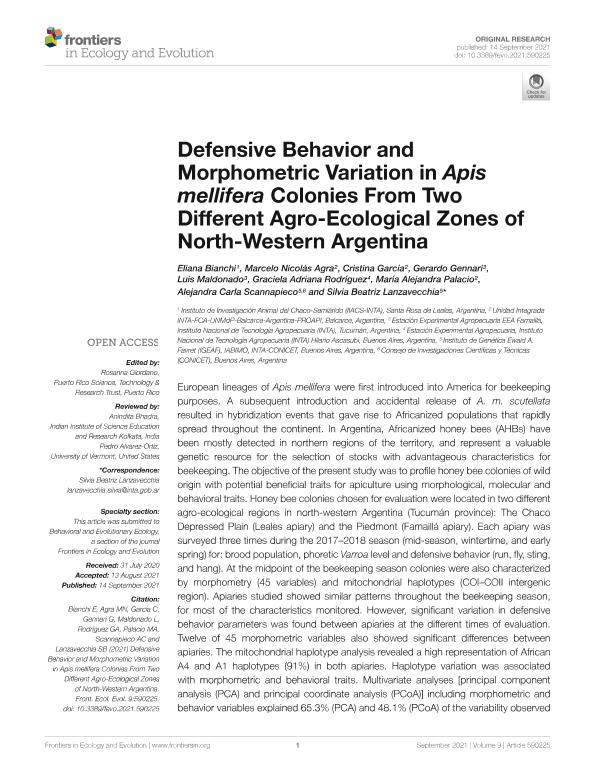Artículo
Defensive Behavior and Morphometric Variation in Apis mellifera Colonies From Two Different Agro-Ecological Zones of North-Western Argentina
Bianchi, Eliana; Agra, Marcelo Nicolás; García, Cristina; Gennari, Gerardo Pablo; Maldonado, Luis María; Rodriguez, Graciela Adriana; Palacio, Maria Alejandra; Scannapieco, Alejandra Carla ; Lanzavecchia, Silvia Beatriz
; Lanzavecchia, Silvia Beatriz
 ; Lanzavecchia, Silvia Beatriz
; Lanzavecchia, Silvia Beatriz
Fecha de publicación:
09/2021
Editorial:
Frontiers Media S.A.
Revista:
Frontiers in Ecology and Evolution
ISSN:
2296-701X
Idioma:
Inglés
Tipo de recurso:
Artículo publicado
Clasificación temática:
Resumen
European lineages of Apis mellifera were first introduced into America for beekeeping purposes. A subsequent introduction and accidental release of A. m. scutellata resulted in hybridization events that gave rise to Africanized populations that rapidly spread throughout the continent. In Argentina, Africanized honey bees (AHBs) have been mostly detected in northern regions of the territory, and represent a valuable genetic resource for the selection of stocks with advantageous characteristics for beekeeping. The objective of the present study was to profile honey bee colonies of wild origin with potential beneficial traits for apiculture using morphological, molecular and behavioral traits. Honey bee colonies chosen for evaluation were located in two different agro-ecological regions in north-western Argentina (Tucumán province): The Chaco Depressed Plain (Leales apiary) and the Piedmont (Famaillá apiary). Each apiary was surveyed three times during the 2017–2018 season (mid-season, wintertime, and early spring) for: brood population, phoretic Varroa level and defensive behavior (run, fly, sting, and hang). At the midpoint of the beekeeping season colonies were also characterized by morphometry (45 variables) and mitochondrial haplotypes (COI–COII intergenic region). Apiaries studied showed similar patterns throughout the beekeeping season, for most of the characteristics monitored. However, significant variation in defensive behavior parameters was found between apiaries at the different times of evaluation. Twelve of 45 morphometric variables also showed significant differences between apiaries. The mitochondrial haplotype analysis revealed a high representation of African A4 and A1 haplotypes (91%) in both apiaries. Haplotype variation was associated with morphometric and behavioral traits. Multivariate analyses [principal component analysis (PCA) and principal coordinate analysis (PCoA)] including morphometric and behavior variables explained 65.3% (PCA) and 48.1% (PCoA) of the variability observed between colonies in the first two components. Several morphometric parameters and “fly” behavior were mainly associated with the separation of the colonies. The results from this study point to a possible association between morphometric and behavioral variation and the adaptation of honey bee colonies to differential agro-ecological conditions. We discuss how the detected variation between apiaries can be used for the selection and preservation of honey bee ecotypes in regional breeding programs.
Palabras clave:
DEFENSIVENESS
,
ENVIRONMENT
,
HONEY BEES
,
MITOCHONDRIAL HAPLOTYPE
,
MORPHOMETRY
Archivos asociados
Licencia
Identificadores
Colecciones
Articulos (IABIMO)
Articulos de INSTITUTO DE AGROBIOTECNOLOGIA Y BIOLOGIA MOLECULAR
Articulos de INSTITUTO DE AGROBIOTECNOLOGIA Y BIOLOGIA MOLECULAR
Citación
Bianchi, Eliana; Agra, Marcelo Nicolás; García, Cristina; Gennari, Gerardo Pablo; Maldonado, Luis María; et al.; Defensive Behavior and Morphometric Variation in Apis mellifera Colonies From Two Different Agro-Ecological Zones of North-Western Argentina; Frontiers Media S.A.; Frontiers in Ecology and Evolution; 9; 9-2021; 1-13
Compartir
Altmétricas



